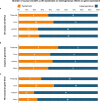Profiling RNA-Seq at multiple resolutions markedly increases the number of causal eQTLs in autoimmune disease
- PMID: 29059182
- PMCID: PMC5695635
- DOI: 10.1371/journal.pgen.1007071
Profiling RNA-Seq at multiple resolutions markedly increases the number of causal eQTLs in autoimmune disease
Abstract
Genome-wide association studies have identified hundreds of risk loci for autoimmune disease, yet only a minority (~25%) share genetic effects with changes to gene expression (eQTLs) in immune cells. RNA-Seq based quantification at whole-gene resolution, where abundance is estimated by culminating expression of all transcripts or exons of the same gene, is likely to account for this observed lack of colocalisation as subtle isoform switches and expression variation in independent exons can be concealed. We performed integrative cis-eQTL analysis using association statistics from twenty autoimmune diseases (560 independent loci) and RNA-Seq data from 373 individuals of the Geuvadis cohort profiled at gene-, isoform-, exon-, junction-, and intron-level resolution in lymphoblastoid cell lines. After stringently testing for a shared causal variant using both the Joint Likelihood Mapping and Regulatory Trait Concordance frameworks, we found that gene-level quantification significantly underestimated the number of causal cis-eQTLs. Only 5.0-5.3% of loci were found to share a causal cis-eQTL at gene-level compared to 12.9-18.4% at exon-level and 9.6-10.5% at junction-level. More than a fifth of autoimmune loci shared an underlying causal variant in a single cell type by combining all five quantification types; a marked increase over current estimates of steady-state causal cis-eQTLs. Causal cis-eQTLs detected at different quantification types localised to discrete epigenetic annotations. We applied a linear mixed-effects model to distinguish cis-eQTLs modulating all expression elements of a gene from those where the signal is only evident in a subset of elements. Exon-level analysis detected disease-associated cis-eQTLs that subtly altered transcription globally across the target gene. We dissected in detail the genetic associations of systemic lupus erythematosus and functionally annotated the candidate genes. Many of the known and novel genes were concealed at gene-level (e.g. IKZF2, TYK2, LYST). Our findings are provided as a web resource.
Conflict of interest statement
The authors have declared that no competing interests exist.
Figures






References
-
- Fever FM. NIH Progress in Autoimmune Diseases Research. in National Institute of Health Publication. 2005; 17–7576.
-
- Parkes M, Cortes A, van Heel DA, Brown MA. Genetic insights into common pathways and complex relationships among immune-mediated diseases. Nat Rev Genet. Nature Publishing Group; 2013;14: 661–73. doi: 10.1038/nrg3502 - DOI - PubMed
-
- Hindorff LA, Sethupathy P, Junkins HA, Ramos EM, Mehta JP, Collins FS, et al. Potential etiologic and functional implications of genome-wide association loci for human diseases and traits. Proc Natl Acad Sci U S A. 2009;106: 9362–9367. doi: 10.1073/pnas.0903103106 - DOI - PMC - PubMed
-
- Westra H-J, Franke L. From genome to function by studying eQTLs. Biochim Biophys Acta. Elsevier B.V.; 2014;1842: 1896–1902. doi: 10.1016/j.bbadis.2014.04.024 - DOI - PubMed
-
- Klionsky DJ. Crohn’s disease, autophagy, and the Paneth cell. N Engl J Med. 2009;360: 1785–1786. doi: 10.1056/NEJMcibr0810347 - DOI - PMC - PubMed
MeSH terms
Grants and funding
LinkOut - more resources
Full Text Sources
Other Literature Sources
Medical

